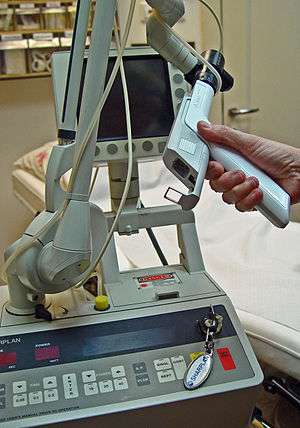Laser scalpel

A laser scalpel is a scalpel for surgery, cutting or ablating living biological tissue by the energy of laser light. The laser scalpel was invented in 1964.[1] In soft tissue laser surgery, a laser beam ablates or vaporizes the soft tissue with high water content. Diode, Nd: and Er:YAG, and CO2 lasers are used most commonly in soft tissue surgery.
CO2 lasers are best for cutting soft tissue because their wavelength is most absorbed by water.[2][3] The focused CO2 laser beam vaporizes tissue precisely, with little thermal damage to surrounding tissues (thermal coagulation zone is as little as 50 microns). The surgical outcome is thus safe and predictable. The CO2 laser is used in virtually all soft tissue procedures, including face lifts, tumor excision, and surgeries in the oral cavity. CO2 laser surgery is praised for minimized bleeding, less swelling and discomfort, reduced infection risk, and less procedure time, as compared to traditional scalpel surgery. Applications include oral surgery, periodontal surgery, oncological surgery, among many others.[4]
In ophthalmology, excimer lasers are used for changing the shape of the cornea, procedures known as LASIK and LASEK.
Other surgical fields where the use of a laser scalpel is common are circumcision, neurosurgery and vascular surgery.
For research use in cell biology, special laser micro-scalpels can make cuts smaller than a single cell.
Laser lancets, e.g. Lasette or LaserDoc, are used as a less painful alternative for drawing small amounts (up to 100 µl) of capillary blood, e.g. for diabetic glucose tests. An adjustable-power flashlamp or diode pumped pulsed Er:YAG laser is typically used. A 150 mJ pulse (focused to 6 J/mm2) can vaporize a 0.025 mm2 of skin to 0.5 mm depth.[5]
Today diode lasers, Nd:YAG and Er:YAG (and their variants, differing by pumping methods and host crystal type, e.g. Er,Cr:YSGG laser), and CO2 lasers are most commonly used, but possible benefits of using the vastly more expensive free electron lasers are being researched.
See also
Literature
- D.H. Sliney, S.L. Trokel: Medical lasers and their safe use, ISBN 3-540-97856-9
- Leon Danaila, Mihail-Lucian Pascu: Lasers in Neurosurgery, 2001, ISBN 973-27-0802-6
- K. K. Jain: Handbook of Laser Neurosurgery, 1983, ISBN 0-398-04844-4
References
- ↑ www.physiciansequipmentblog.com
- ↑ Fisher, JC (1987). Endoscopic Laser Surgery Handbook. New York, NY: Marcel Dekker. pp. 1–130.
- ↑ Levine, R; Vitruk, P (2015). "Laser-Assisted Operculectomy". Compend Contin Educ Dent: 561–7. PMID 26355439.
- ↑ "Soft-Tissue Laser Surgery". LightScalpel.
- ↑ https://www.google.com/patents/US5947957